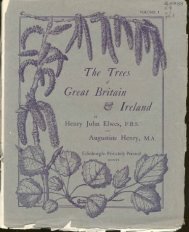THE METAMORPHOSES OF PUBLIUS OVIDIUS NASO
THE METAMORPHOSES OF PUBLIUS OVIDIUS NASO
THE METAMORPHOSES OF PUBLIUS OVIDIUS NASO
Create successful ePaper yourself
Turn your PDF publications into a flip-book with our unique Google optimized e-Paper software.
86<br />
P. OVIDII <strong>NASO</strong>NIS<br />
Mox, ubi creverunt, raturaque mitior illis<br />
Contigit, ut quaedam, sic non manifesta, videri<br />
Forma potest hominis ; sed uti de marmore coepto<br />
Non exacta satis, rudibusque simillima signisi.y<br />
Quae tamen exjllis aliquo pjors humida succo, V1<br />
Et terrena fuit, versa"est mcorpBris^usum;<br />
Quod solidum est, flcctique nequit, mutatur in ossa ;<br />
Quod mod6 vena fuit, sub eodem nomine mansit.<br />
Inque brevi spatio, Superorum munere, saxa<br />
Missa viri manibus facicm traxere virilem ;<br />
Et de foBmineo reparata est fosmina jactu.<br />
Inde genus durum sumus, experiensque laborum;<br />
Et documenta damus, qua simus engine nati.<br />
35. Ubi creverunt: when they grew<br />
-arger.<br />
35. Natura mitior : a milder nature.<br />
When the stone became flesh and muscles.<br />
Faulatimque anima caluerunt mollm saxa.<br />
, JuVEXAt.<br />
36. Qitfrdam forma hominis: some form<br />
of a man.<br />
37. Marmore ccepto: of the marble com<br />
menced to be formed into a statue.<br />
38. liudibus signis: rude statues.<br />
^3,9. Qua pars lnimida: whatever part<br />
is moist. The soft and earthy portions of<br />
the stones are changed into the fluids and<br />
flesh of the body ; the more solid parts<br />
into bones.<br />
40. In carports mum: into the use of the<br />
body; the fleshy parts of the body.<br />
42. Vena. The veins that run through<br />
the stones, remained under the same name;<br />
formed the veins of the human body.<br />
What is the subject of this Fable ?<br />
What oracle did Deucalion and Pyrrha<br />
consult ?<br />
Where is the river Cephisus ?<br />
What memorials of the flood did the<br />
heathens have ?<br />
Of what was the tripod, and the oracular<br />
vapor at Delphi an imitation ?<br />
What response did Deucalion and Pyrrha<br />
receive ?<br />
Was Pyrrha willing, at first, to obey the<br />
oracle ?<br />
How did Deucalion at length interpret<br />
the response ?<br />
NOT-iE.<br />
QTJjESTIONES.<br />
LIBEB I.<br />
35 umQue rigorem; mol-<br />
lirique mora, mollita-<br />
que ducere forrnam.<br />
Mox, ubi creverunt,<br />
mitiorque natura con-<br />
tigit illis, ut qiui'.dam<br />
forma hominis polest<br />
videri, sic non maiu-<br />
40 festa.<br />
41. Quod est soli-<br />
dun, ncquilque floctl<br />
mututur in osaa; quod<br />
modb fuit vena,<br />
IU. Inque brevi spa<br />
tio, munere Supero<br />
rum, saxa nussa mu-<br />
45 nibus viri traxcre<br />
virilem faciem; et<br />
foemina reparuta est<br />
de fcemineo jactu.<br />
43. Superorum munere: by the power ol<br />
the gods; by the divine agency.<br />
44. Viri manibus : by the hands of the<br />
man; of Deucalion.<br />
44. Traxere : assumed, put on.<br />
44. Faciem virilem : the form of a man.<br />
45. Separata est fcemina : woman was<br />
restored.<br />
Et maribus nudas osiendit Pyrrlia pwllas.<br />
JUVENAL.<br />
45. Fosmina jactu: by the throwing of<br />
the woman.<br />
46. Durum genus: a hardy race.<br />
The poet seems to indulge in a witticism,<br />
by using the word durum, hard, as an epi<br />
thet of the race descended from stones. So<br />
Virgil:<br />
Deucalion vacuum lapides jactavitin orbem:<br />
Unde homines iiati, durum genus. GBOBG. i. 62.<br />
47. Documenta damus: we give proofs;<br />
we give evidence.<br />
In what twofold sense was the Earth<br />
their great parent ?<br />
Did they obey the oracle as interpreted<br />
by Deucalion ?<br />
What was the result ?<br />
Who produced the males ?<br />
Who produced the females ?<br />
What witticism does the poet employ in<br />
speaking of a race descended from stones?<br />
What erroneous views do some offer as<br />
an interpretation of the fable ?<br />
In what mainly consists the error ?<br />
Where will we find the true solution ot<br />
the fable ?<br />
t'ABULA X. METAMORPHOSED N. 87<br />
What was the main cause of the depo<br />
pulation of the world by the deluge ?<br />
What was to be the means of its re<br />
storation ?<br />
What kind of an oltar did Noah burld<br />
unto the Lord ?<br />
In what respect did God bless him and<br />
his children in consequence thereof?<br />
What is a proof of this extraordinary<br />
increase of population ?<br />
How then may this increase be said to<br />
be a reproduction of men from stones 1<br />
How does this apply to the case of Deu<br />
calion ?<br />
Were Deucalion and Noah the same<br />
person ?<br />
What remark of Sanchoniatho probably<br />
has allusion to this repeopling of the earth<br />
by stones ?<br />
What were the Baithuli ?<br />
How does Lucian, in his treatise on the<br />
Syrian goddess, say that the water of the<br />
flood disappeared ?<br />
Was there any ceremony in commemo*<br />
ration of it ?<br />
4 Ii<br />
IP













